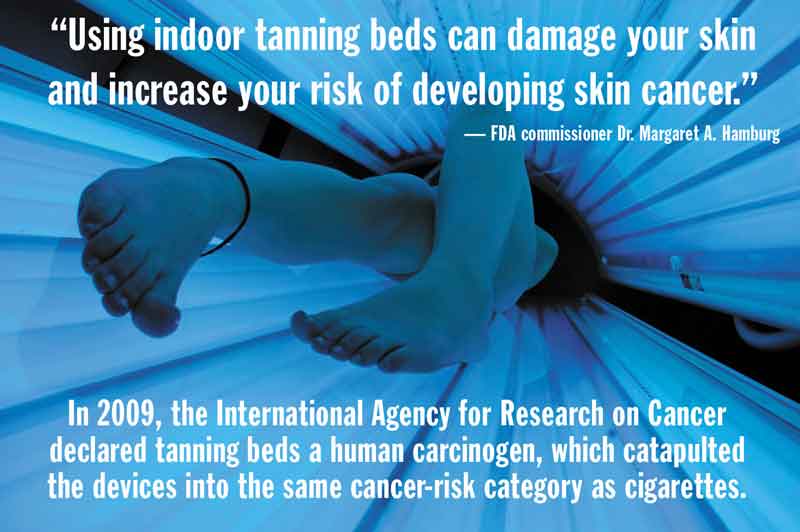Despite the hoopla over dysfunction in Washington, the government still can do useful things. To prove it, the Food and Drug Administration should move aggressively to implement and then strengthen its proposed cancer warnings about tanning beds.
A stunning 20 million to 30 million Americans each year use tanning beds. Use is particularly concentrated among young white women. The Centers for Disease Control and Prevention estimated that about 30 percent of white women between the ages of 18 and 25 used an indoor tanning machine in 2010. And about 60 percent of that group did so at least 10 times during the year.
The ultraviolet radiation from indoor tanning far exceeds that of the natural sun. For example, tanning machines’ output of UVA rays, which cause skin darkening, is at least four times that of natural sunlight, even the rays during the summer at noon in Washington. The UVB output, which causes burns, is about twice that of natural sunlight.
Studies suggest that people who use indoor tanning before age 35 increase their risk of melanoma (the most serious type of skin cancer) by about 75 percent. Similarly, the National Cancer Institute estimates that women who use indoor tanning at least once a month are 55 percent more likely to develop melanoma.
The Indoor Tanning Association, an industry lobbying group, has claimed that indoor tanning is safer than exposure to natural sunlight. But the Federal Trade Commission has found those claims to be false, and forced the association to stop making them.
All of which is why excessive indoor tanning by young women is particularly troubling. Many high school girls, for example, use tanning beds frequently before their proms — without realizing the harm that they may be doing to themselves.
The rate of melanoma among young U.S. adults has been rising rapidly. In 1973, for example, about 6 in every 100,000 white women ages 15 to 39 were diagnosed with melanoma. By 2004, that rate had more than doubled to about 14 per 100,000. The good news is that the mortality rate from melanoma has been declining, perhaps because of earlier detection and better treatment.
So what can we do?
First, if you’ve used indoor tanning beds extensively, get a melanoma screening. Such screening may not make sense for the general population, but it does for those at high risk, which includes people who have used indoor tanning a lot.
Second, pediatricians and other doctors could be even more forceful in warning about the risks for young people, as urged in a March article in Pediatrics by Sophie Balk of Children’s Hospital at Montefiore, David Fisher of Harvard Medical School and Alan Geller of the Harvard School of Public Health.
Third, more states should consider banning indoor tanning for those younger than 18. California and Vermont already have, along with a variety of cities, including Chicago. At the very least, all states should ban indoor tanning for minors without written permission from parents.
Fourth, in the Affordable Care Act, the Obama administration imposed a 10 percent excise tax on indoor tanning services to help pay for expanded health insurance coverage. The inspector general at the Treasury Department, however, reported in 2011 that the tax was being collected from less than half of the expected number of tanning facilities.
Treasury should more aggressively collect this tax, and Congress should consider raising it to 25 percent or even 50 percent. If Congress won’t act, states should impose higher taxes themselves. In other areas, including cigarette smoking, significantly increased taxes along with a public health effort have helped to reduce use among younger adults.
Finally, in May, the FDA proposed tighter regulatory oversight of tanning beds along with new warnings about cancer risks. This is welcome, but not enough: The proposed warnings, for example, would be placed on promotional materials and websites, rather than the machines themselves. The FDA should finish its regulations quickly, and then follow up with even tighter standards if these relatively weak warnings don’t do much to discourage use.
The bottom line is that melanoma and other skin cancers from indoor tanning use are entirely preventable. In an era of increasing concern about rising health costs, aren’t these steps the least we should be doing?
Peter Orszag is vice chairman of corporate and investment banking and chairman of the financial strategy and solutions group at Citigroup and a former director of the Office of Management and Budget in the Obama administration. This column was distributed by Bloomberg News, where it first appeared.
Send questions/comments to the editors.



Success. Please wait for the page to reload. If the page does not reload within 5 seconds, please refresh the page.
Enter your email and password to access comments.
Hi, to comment on stories you must . This profile is in addition to your subscription and website login.
Already have a commenting profile? .
Invalid username/password.
Please check your email to confirm and complete your registration.
Only subscribers are eligible to post comments. Please subscribe or login first for digital access. Here’s why.
Use the form below to reset your password. When you've submitted your account email, we will send an email with a reset code.